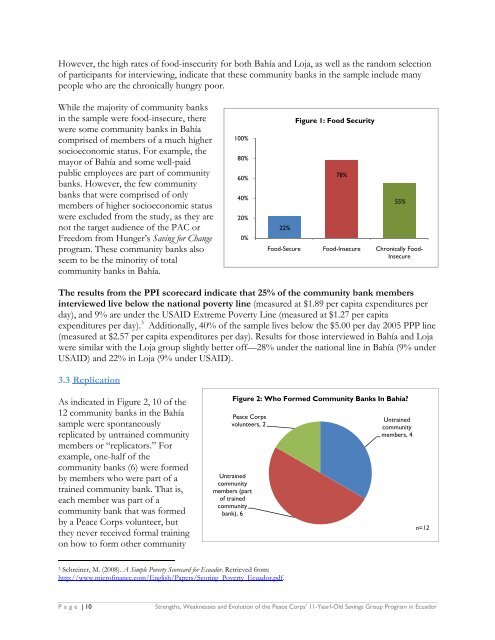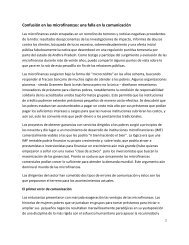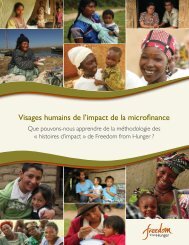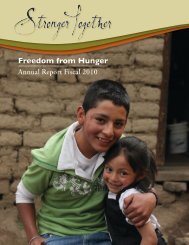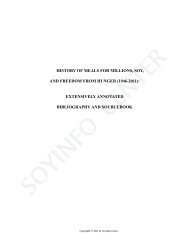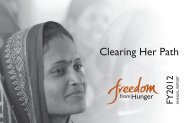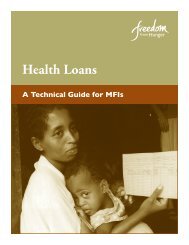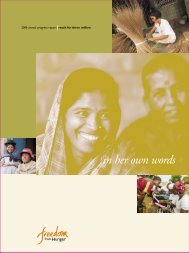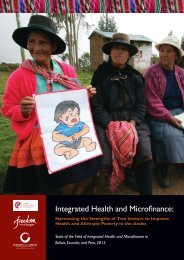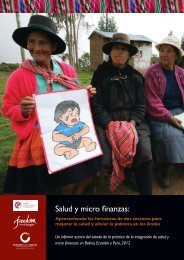Strengths, Weaknesses and Evolution of the Peace Corps' 11-Year ...
Strengths, Weaknesses and Evolution of the Peace Corps' 11-Year ...
Strengths, Weaknesses and Evolution of the Peace Corps' 11-Year ...
You also want an ePaper? Increase the reach of your titles
YUMPU automatically turns print PDFs into web optimized ePapers that Google loves.
However, <strong>the</strong> high rates <strong>of</strong> food-insecurity for both Bahía <strong>and</strong> Loja, as well as <strong>the</strong> r<strong>and</strong>om selection<br />
<strong>of</strong> participants for interviewing, indicate that <strong>the</strong>se community banks in <strong>the</strong> sample include many<br />
people who are <strong>the</strong> chronically hungry poor.<br />
While <strong>the</strong> majority <strong>of</strong> community banks<br />
in <strong>the</strong> sample were food-insecure, <strong>the</strong>re<br />
were some community banks in Bahía<br />
comprised <strong>of</strong> members <strong>of</strong> a much higher<br />
socioeconomic status. For example, <strong>the</strong><br />
mayor <strong>of</strong> Bahía <strong>and</strong> some well-paid<br />
public employees are part <strong>of</strong> community<br />
banks. However, <strong>the</strong> few community<br />
banks that were comprised <strong>of</strong> only<br />
members <strong>of</strong> higher socioeconomic status<br />
were excluded from <strong>the</strong> study, as <strong>the</strong>y are<br />
not <strong>the</strong> target audience <strong>of</strong> <strong>the</strong> PAC or<br />
Freedom from Hunger’s Saving for Change<br />
program. These community banks also<br />
seem to be <strong>the</strong> minority <strong>of</strong> total<br />
community banks in Bahía.<br />
The results from <strong>the</strong> PPI scorecard indicate that 25% <strong>of</strong> <strong>the</strong> community bank members<br />
interviewed live below <strong>the</strong> national poverty line (measured at $1.89 per capita expenditures per<br />
day), <strong>and</strong> 9% are under <strong>the</strong> USAID Extreme Poverty Line (measured at $1.27 per capita<br />
expenditures per day). 3 Additionally, 40% <strong>of</strong> <strong>the</strong> sample lives below <strong>the</strong> $5.00 per day 2005 PPP line<br />
(measured at $2.57 per capita expenditures per day). Results for those interviewed in Bahía <strong>and</strong> Loja<br />
were similar with <strong>the</strong> Loja group slightly better <strong>of</strong>f—28% under <strong>the</strong> national line in Bahía (9% under<br />
USAID) <strong>and</strong> 22% in Loja (9% under USAID).<br />
3.3 Replication<br />
As indicated in Figure 2, 10 <strong>of</strong> <strong>the</strong><br />
12 community banks in <strong>the</strong> Bahía<br />
sample were spontaneously<br />
replicated by untrained community<br />
members or “replicators.” For<br />
example, one-half <strong>of</strong> <strong>the</strong><br />
community banks (6) were formed<br />
by members who were part <strong>of</strong> a<br />
trained community bank. That is,<br />
each member was part <strong>of</strong> a<br />
community bank that was formed<br />
by a <strong>Peace</strong> Corps volunteer, but<br />
<strong>the</strong>y never received formal training<br />
on how to form o<strong>the</strong>r community<br />
100%<br />
3 Schreiner, M. (2008). A Simple Poverty Scorecard for Ecuador. Retrieved from:<br />
http://www.micr<strong>of</strong>inance.com/English/Papers/Scoring_Poverty_Ecuador.pdf.<br />
80%<br />
60%<br />
40%<br />
20%<br />
0%<br />
Figure 2: Who Formed Community Banks In Bahía?<br />
<strong>Peace</strong> Corps<br />
volunteers, 2<br />
Untrained<br />
community<br />
members (part<br />
<strong>of</strong> trained<br />
community<br />
bank), 6<br />
Untrained<br />
community<br />
members, 4<br />
Page | 10 <strong>Strengths</strong>, <strong>Weaknesses</strong> <strong>and</strong> <strong>Evolution</strong> <strong>of</strong> <strong>the</strong> <strong>Peace</strong> Corps’ <strong>11</strong>-<strong>Year</strong>l-Old Savings Group Program in Ecuador<br />
22%<br />
Figure 1: Food Security<br />
78%<br />
55%<br />
Food-Secure Food-Insecure Chronically Food-<br />
Insecure<br />
n=12


